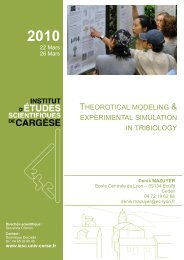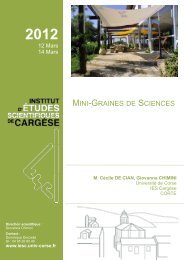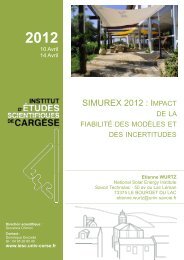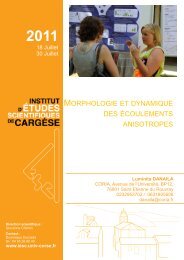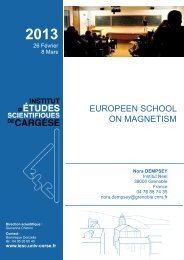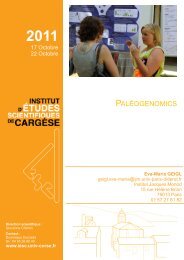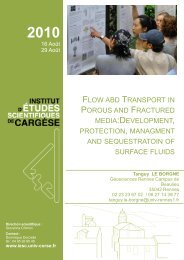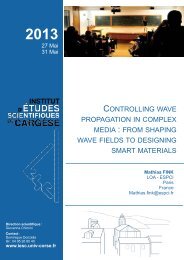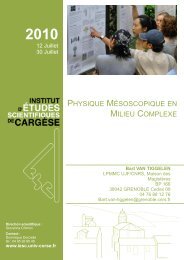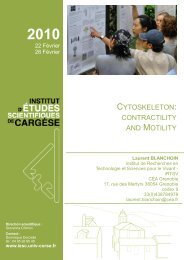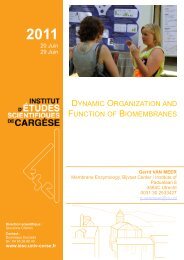nanoelectronics - Institut d'Études Scientifiques de Cargèse (IESC)
nanoelectronics - Institut d'Études Scientifiques de Cargèse (IESC)
nanoelectronics - Institut d'Études Scientifiques de Cargèse (IESC)
You also want an ePaper? Increase the reach of your titles
YUMPU automatically turns print PDFs into web optimized ePapers that Google loves.
Tuesday<br />
Scattering theory of nonlinear thermoelectric transport<br />
David Sánchez<br />
<strong>Institut</strong>e for Cross-Disciplinary Physics and Complex Systems IFISC (UIB-CSIC), E-07122<br />
Palma <strong>de</strong> Mallorca, Spain<br />
We discuss nonlinear transport properties of quantum conductors in response to both<br />
electrical and thermal driving forces. Within scattering approach, we <strong>de</strong>termine the<br />
nonequilibrium screening potential of a generic mesoscopic system and find that its response<br />
is dictated by particle and entropic injectivities which <strong>de</strong>scribe the charge and entropy<br />
transfer during transport. We illustrate our mo<strong>de</strong>l analyzing the voltage and thermal<br />
rectification of a resonant tunneling barrier. Importantly, we investigate interaction induced<br />
contributions to the thermopower in the presence of large temperature differences [1].<br />
[1] D. Sánchez and R. López, arxiv:1209.1264 (preprint, 2012).<br />
__________________________________________________________________________<br />
Magnon-driven quantum-dot heat engine<br />
Björn Sothmann, Markus Büttiker<br />
Département <strong>de</strong> Physique Théorique, Université <strong>de</strong> Genève, CH-1211 Genève 4,<br />
Switzerland<br />
The concept of harvesting energy from the environment to power small <strong>de</strong>vices has become<br />
increasingly popular. Recently, there was a particular interest in quantum dot systems that<br />
generate electrical currents from thermal fluctuations [1,2]. The main focus of the emergent<br />
field of spin caloritronics is the i<strong>de</strong>a to drive and control spin currents by heat.<br />
Here, we discuss a setup consisting of a single-level quantum dot coupled to two<br />
ferromagnetic metals and a ferromagnetic insulator held at different temperatures which<br />
combines the i<strong>de</strong>as of energy harvesting and spin caloritronics. We <strong>de</strong>monstrate that this<br />
nanoengine can act as an optimal heat to spin-polarized charge current converter in an<br />
antiparallel geometry, while it acts as a heat to pure spin current converter in the parallel<br />
case. We discuss the maximal output power of the <strong>de</strong>vice and its efficiency [3].<br />
[1] R. Sánchez, M. Büttiker, Optimal energy quanta to current conversion, PRB 83, 085428<br />
(2011)<br />
[2] B. Sothmann, R. Sánchez, A. N. Jordan, M. Büttiker, Rectification of thermal fluctuations<br />
in a chaotic cavity heat engine, PRB 85, 205301 (2012)<br />
[3] B. Sothmann, M. Büttiker, Magnon-driven quantum-dot heat engine, EPL 99 27001 (2012)



